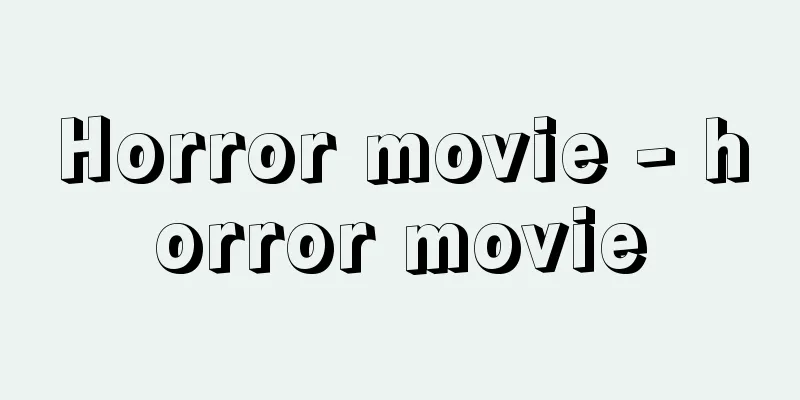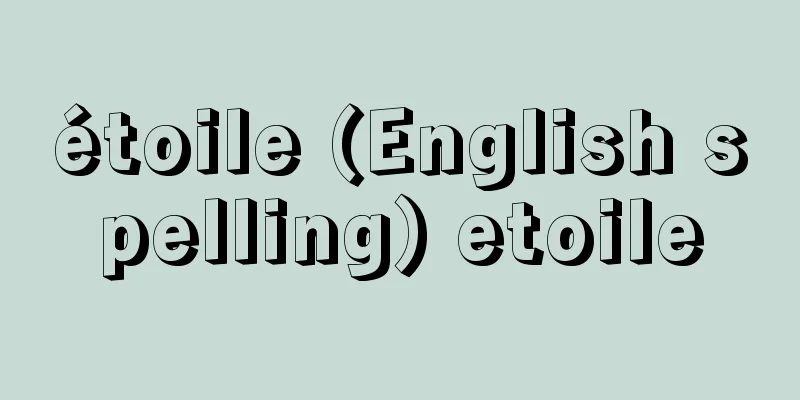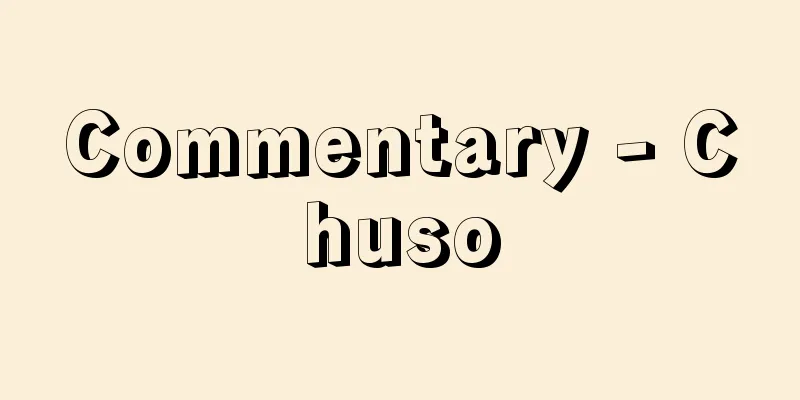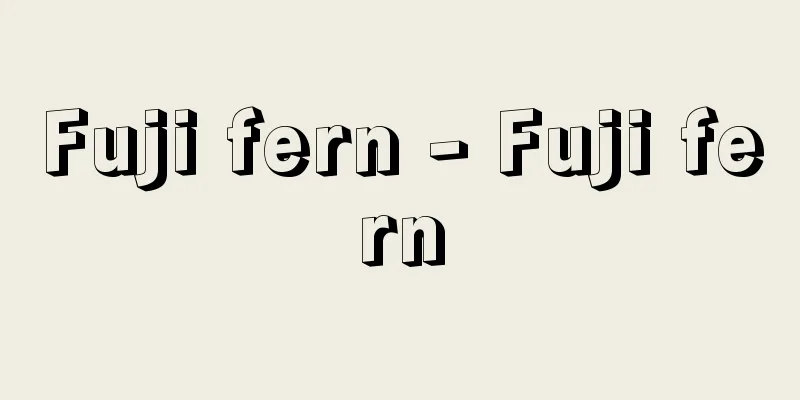Horror movie - horror movie

|
A general term for films made to satisfy the curiosity of audiences who want to experience "safe fear." Also known as horror films. It includes weird films featuring ghosts, shape-shifting monsters, and monsters, neurotic thrillers that deal with the violent acts of abnormal people, and science fiction films that depict the "confusion and fear of people faced with abnormal situations." While there are many second- or third-rate, cheap films, there are also works that pursue poetry in fear and the beauty of thrills, so the range is extremely wide. German Expressionist films from around 1910 included some eerie works that could be called artistic horror films. In the 1930s, films such as Dracula, Frankenstein, and The Wolf Man, produced by the American company Universal Pictures, became hits and were made into series, becoming horror film classics today. After World War II, the French suspense film master Henri-Georges Clouzot released the ghost story-style murder thriller Les Diaboliques (1954). The climax bathtub scene was shocking, and it was remade in the United States in 1996, directed by Jeremiah S. Chechik (1955- ) and starring Sharon Stone (1958- ). The British studio Hammer Productions revived the monsters from Universal's old movies, releasing films such as Terence Fisher's (1904-1980) masterpiece Dracula (1958). The American Roger Corman also adapted a series of horror stories by E. A. Poe into film, which had a unique style and humor. Meanwhile, thriller master Hitchcock's Psycho (1960, remade by Gus Van Sant in 1998) and The Birds (1963) can be considered masterpieces that pioneered the genre of films that dealt with serial murders by a psychopath and attacks by the natural world, respectively. Among them, William Castle (1914-1977), who liked gimmicks, superimposed a clock face on the screen with the sound of a heartbeat just before the climax of The Third Crime (1959), and inserted a narrator who said, "Those with weak hearts should leave in one minute," so that the shock of the moment was in fact waiting. It was dismissed as a copy of Hitchcock's Psycho, but it was a real surprise. Castle later produced Rosemary's Baby (1968), a demon-possession story starring Roman Polanski, who was originally horror-oriented. Night of the Living Dead (1968), by George A. Romero (1940-2017), who can be said to be the founder of the zombie genre, was also made around this time. The 1970s began with a short film called Jessica (1971) by John Hancock (1939-). The film is about a neurotic (mentally disabled) woman who has been discharged from hospital and moves to the countryside. The strange events she experiences there leave the audience confused, wondering whether they are the protagonist's delusions or whether the place she has moved to is a village of vampires. However, it received little recognition, and the attention was focused on William Friedkin's (1939-) The Exorcist (1973). The horror film boom that began with the success of this film was characterized by the fact that it broke the conventional image of a silly film and appeared as a first-class blockbuster directed by an Academy Award-winning director. However, this soon gave rise to a proliferation of first-class blockbuster-like works in which the coherence of the story was of secondary importance. The most prominent example of this is the Italian Dario Argento's (1943- ) Suspiria (1977), which shocked the audience with a series of grotesque scenes. Since this hit, there has been no end to films about proxy wars between God and the Devil, or the violent acts of insane people. Among them, however, there are the devil-themed "The Omen" (1976) by Richard Donner (1930-2021), the paranormal "The Texas Chainsaw Massacre" (1974) by Tobe Hooper (1943-2017), the paranormal "The Texas Chainsaw Massacre" (1974) by Marcus Nispel in 2003 under the title "The Texas Chainsaw Massacre" and the occult "Poltergeist" (1982, produced by Steven Spielberg), Stanley Kubrick's hotel ghost story "The Shining" (1980), Ridley Scott's space monster story "Alien" (1979), the paranormal "Halloween" (1978) by John Carpenter (1948- ), and Brian De Palma's (1940- )'s school occult film "Carrie" (1976), "Dressed to Kill" (1980) based on "Psycho", Sean S. Cunningham's (1941- ) "Friday the 13th" (1980), Wes Craven's (1939-2015) "Salandra" (1977), "A Nightmare on Elm Street" (1984), "Scream" (1996) and others were produced. These films gradually competed for bloodiness and were called "splatter films", but in America they are usually called "slasher films". In any case, excessive stimulation can turn into laughter, and Sam Raimi's (1959- ) "Evil Dead" (1983) can be said to be humor in bad taste. It is worth noting that "The Texas Chainsaw Massacre" has few depictions of blood, despite the horror of the leather-masked man with the chainsaw. Spielberg's "Jaws" (1975), which depicts a man-eating shark attack, is also a work that uses "fear" as a motif. Jonathan Demme's (1944-2017) "Silence of the Lambs" (1991) has an overwhelming protagonist who is a genius psychologist and a murderer. Many of these have been made into series and remade. In Japan, ghost story films such as those about mysterious cats have been made as program pictures since before the Second World War, but representative postwar works include Nakagawa Nobuo's (1905-1984) "Tōkaidō Yotsuya Kaidan" (1959) and Kato Tai's "Kaidan Oiwa no Yōrei" (1961), and we should not overlook the Japanese vampire series directed by Yamamoto Michio (1933-2004) and starring Kishida Shin (1939-1982). In recent years, mutual influences with manga and games have become prominent in horror films. The boom began with the hit of Hirayama Hideyuki's (1950-) Gakkou no Kaidan (Gakkou no Kaidan) (1995), followed by a double feature of Suzuki Koji's horror novel series, Nakata Hideo's (1961-) Ring (1998) and Iida Joji's (1959-) Spiral (1998), which became a hot topic as a dual movie format. Around this time, the causal relationship between the curser and the cursed became weaker (not just in Japanese films), and the filmmaking style became more shocking than horror, with consistency being secondary and the aim being to simply scare the viewer physically. Among these, Kurosawa Kiyoshi's Loft (2005) and Sakebi (Sakebi) (2006) stood out as absurdist dramas. [Takuya Mori] "The Children of Dr. Caligari - The World of Horror Films" by S.S. Prower, translated by Kenji Fukuma and Hiroshi Fujii (1983, Shobunsha)" ▽ "The Complete Horror Film Collection - A Study of the History of Horror Films" (1996, Tatsumi Publishing)" ▽ "Monster Shows - A Cultural History of Horror Films" by David J. Scull, translated by Reiko Utsugi (1998, Kokusho Kankokai)" ▽ "One Hundred Monsters of the Silver Screen - An Overview of Japanese Horror Films" by Hayato Izumi (2000, Seidosha)" ▽ "The Nightmare from The Movies - Horror Films, Tales of Terror and Mystery" (2000, Neko Publishing)" ▽ "Illustrated Horror Cinema - Mystery and Fantasy on the Silver Screen" by Hajime Ishida (2002, Kawade Shobo Shinsha)" ▽ "Kiyoshi Kurosawa and Makoto Shinozaki, 'Kiyoshi Kurosawa's History of Horror Films' (2003, Seidosha) " "Yoshiaki Washizu, 'The Art of Horror Films: How Horror is Created' (2006, Kinema Junposha)" [References] | | | | | | | | | | | | |Source: Shogakukan Encyclopedia Nipponica About Encyclopedia Nipponica Information | Legend |
|
「安全な怖(こわ)さ」を体験したいという観客の好奇心に応じてつくられた映画の総称。ホラー映画ともいう。幽霊、妖怪変化(ようかいへんげ)、怪物(モンスター)が登場する怪奇映画から、異常者の凶行を扱ったニューロティック・スリラー、さらに「異常な事態に直面した人々の混乱と恐怖」を描いたSF映画まで含まれる。二流・三流の安上がり作品も多い反面、恐怖のなかの詩情、戦慄(せんりつ)の美を追求した作品もあり、その範囲はきわめて幅広い。 1910年ごろからのドイツ表現派映画には、芸術的恐怖映画ともいうべき不気味な作品がある。1930年代には、アメリカのユニバーサル映画が製作した『ドラキュラ』『フランケンシュタイン』『狼男(おおかみおとこ)』などがヒット、シリーズ化され、いまや恐怖映画の古典となっている。第二次世界大戦後、フランスのサスペンス映画の名匠アンリ・ジョルジュ・クルーゾが怪談風謀殺スリラー『悪魔のような女』(1954)を発表。クライマックスの浴槽のシーンは衝撃的であり、1996年にアメリカでジェレマイア・チェチックJeremiah S. Chechik(1955― )監督、シャロン・ストーンSharon Stone(1958― )主演でリメイクされた。 そして往年のユニバーサル映画のモンスターたちを、イギリスのハマー・プロが復活させ、テレンス・フィッシャーTerence Fisher(1904―1980)の代表作『吸血鬼ドラキュラ』(1958)をはじめとする諸作を世に送った。またアメリカのロジャー・コーマンは、E・A・ポーの一連の恐怖物語を映画化し、その風格とユーモアに独得の味があった。一方、スリラーの名匠ヒッチコックの『サイコ』(1960。1998年にガス・バン・サントがリメイク)と『鳥』(1963)は、前者は異常者の連続殺人、後者は自然界の襲撃を扱った作品の先駆をなす傑作といえる。そんななかで、ギミック(仕掛け)好きのウィリアム・キャッスルWilliam Castle(1914―1977)は、たとえば『第三の犯罪』(1959)では、クライマックス直前に心臓の鼓動の音とともに画面に時計の文字盤を重ね、「心臓の弱い人は1分間のうちに去れ」とナレーションを入れ、事実そういうだけのショックが待っているという作り方をした。ヒッチコックの『サイコ』の亜流として片付けられたが、きちんと意外性があった。後にキャッスルは、もともとホラー志向のあるロマン・ポランスキの「悪魔憑(つ)き」ものである『ローズマリーの赤ちゃん』(1968)などを製作した。ゾンビものの開祖といえるジョージ・A・ロメロGeorge A. Romero(1940―2017)の『ナイト・オブ・ザ・リビング・デッド ゾンビの誕生』(1968)も、このころつくられている。 1970年代は、まず、ジョン・ハンコックJohn Hancock(1939― )の『呪われたジェシカ』(1971)という小品がある。退院した神経障害(精神障害)の女性が、移住した田舎で体験する奇怪なできごとが、主人公の幻想なのか、もしかすると移住した先は吸血鬼の村なのか、と観客を迷わせる不気味さが無類だが、ほとんど評価されず、話題はもっぱらウィリアム・フリードキンWilliam Friedkin(1939― )の『エクソシスト』(1973)に集中した。この映画のヒットに始まる恐怖映画ブームの特色は、それが、従来のいかもの映画のイメージを破り、アカデミー賞受賞監督が撮った一流大作として登場したことにある。しかし、それはやがて一流大作もどきの、話のつじつまなど二の次という作品の乱発を生んだ。その筆頭がイタリアのダリオ・アルジェントDario Argento(1943― )の『サスペリア』(1977)で、グロテスクな画面の連続で観客の神経をどぎつく攻めたてた。このヒット以来、「神対悪魔」の代理戦争もの、異常者の凶行ものなどが、いまも後を絶たない。しかしそれらのなかから、リチャード・ドナーRichard Donner(1930―2021)の悪魔もの『オーメン』(1976。2006年にジョン・ムーアがリメイク)、トビー・フーパーTobe Hooper(1943―2017)の異常者もの『悪魔のいけにえ』(1974。2003年にマーカス・ニスペルが『テキサス・チェーンソー』という題でリメイク)やオカルトの『ポルターガイスト』(1982、製作スティーブン・スピルバーグ)、スタンリー・キューブリックのホテル怪異談『シャイニング』(1980)、リドリー・スコットの宇宙モンスターもの『エイリアン』(1979)、ジョン・カーペンターJohn Carpenter(1948― )の異常者もの『ハロウィン』(1978)、ブライアン・デ・パルマBrian De Palma(1940― )の学園オカルト『キャリー』(1976)や『サイコ』を下敷きにした『殺しのドレス』(1980)、ショーン・S・カニンガムSean S. Cunningham(1941― )の『13日の金曜日』(1980)、ウェス・クレイヴンWes Craven(1939―2015)の『サランドラ』(1977)、『エルム街の悪夢』(1984)、『スクリーム』(1996)などが生まれた。これらはしだいに流血度を競うようになり、「スプラッターsplatter(血しぶき)映画」とよばれたが、アメリカでは「スラッシャーSlasher(めった斬り)映画」の呼称が普通。ともあれ、刺激も過剰になると笑いに転じるもので、サム・ライミSam Raimi(1959― )の『死霊のはらわた』(1983)などは、悪趣味のユーモアといえる。『悪魔のいけにえ』が、レザーマスクの電動ノコギリ男の恐怖感のわりに、流血描写が少ないのは特筆していい。また、人食いザメの襲撃を描いたスピルバーグの『ジョーズ』(1975)も、「恐怖」をモチーフにした作品の一つである。ジョナサン・デミJonathan Demme(1944―2017)の『羊たちの沈黙』(1991)は、天才心理学者にして殺人鬼という主人公が圧倒的だった。これらの多くはシリーズ化され、リメイクもされている。 日本では、第二次世界大戦前から怪猫ものなどの怪談映画がプログラム・ピクチャーとしてつくられているが、戦後の代表作として、中川信夫(1905―1984)の『東海道四谷(よつや)怪談』(1959)、加藤泰(たい)の『怪談お岩の亡霊』(1961)などがあり、また山本迪夫(みちお)(1933―2004)監督・岸田森(しん)(1939―1982)主演の和製吸血鬼シリーズも見落とすことができない。近年のホラー映画は、漫画やゲームとの相互影響が色濃くなった。ブームは、まず、平山秀幸(1950― )の『学校の怪談』(1995)のヒットに始まり、鈴木光司の連作のホラー小説から、中田秀夫(1961― )の『リング』(1998)、飯田譲治(1959― )の『らせん』(1998)が2本立てで上映され、デュアル・ムービー形態が話題となった。またこのころから、(日本映画に限らず)祟(たた)る側、祟られる側の因果関係が希薄になり、つじつまは二の次で、とにかく生理的に脅かそうという、ホラーというよりショッカーの作り方になってきた。そんななかで、黒沢清の『LOFT(ロフト)』(2005)、『叫(さけび)』(2006)などが不条理ドラマ的に際だっている。 [森 卓也] 『S・S・プロウアー著、福間健二・藤井寛訳『カリガリ博士の子どもたち――恐怖映画の世界』(1983・晶文社)』▽『『恐怖映画大全――怪奇映画史大研究』(1996・辰巳出版)』▽『デイヴィッド・J・スカル著、栩木玲子訳『モンスター・ショー――怪奇映画の文化史』(1998・国書刊行会)』▽『泉速之著『銀幕の百怪――本朝怪奇映画大概』(2000・青土社)』▽『『The Nightmare from The Movies――ホラー映画 戦慄と怪奇の物語』(2000・ネコ・パブリッシング)』▽『石田一著『図説 ホラー・シネマ――銀幕の怪奇と幻想』(2002・河出書房新社)』▽『黒沢清・篠崎誠著『黒沢清の恐怖の映画史』(2003・青土社)』▽『鷲巣義明著『恐怖の映画術――ホラーはこうして創られる』(2006・キネマ旬報社)』 [参照項目] | | | | | | | | | | | | | |出典 小学館 日本大百科全書(ニッポニカ)日本大百科全書(ニッポニカ)について 情報 | 凡例 |
Recommend
Dermal dermatitis (English)
… Dermatitis can be broadly divided into two type...
Reciprocity - Goshuu (English spelling)
Human actions are performed in the hope of receivi...
Collenia
...In stromatolites from before the Mesozoic era,...
Dogfish - Dogfish
A general term for a family or genus of the order...
Selye, Hans
Born January 26, 1907 in Vienna, Austria-Hungary [...
Land survey items
The regulations for implementing land surveys appe...
Whooping cough - pertussis
It is an acute infectious disease of the respirat...
Fossil Primates - Kasekireichourui (English spelling)
Primates discovered as fossils. It is believed tha...
Zelle, MG (English spelling) ZelleMG
...Dutch dancer known as a beautiful female spy. ...
larch
...It has local names such as Fujimatsu (illustra...
Perissodactyla
…a group of hoofed, herbivorous or folivorous mam...
Aceh War - Aceh War (English spelling)
A series of wars that took place in the Aceh Kingd...
Verein Deutscher Ingenieure
…As a result, from the mid-19th century onwards, ...
terrier
…Of these, the English Pointer and the English Se...
Nanga Parbat (mountain)
Located in the Himalayan range in western Kashmir,...









